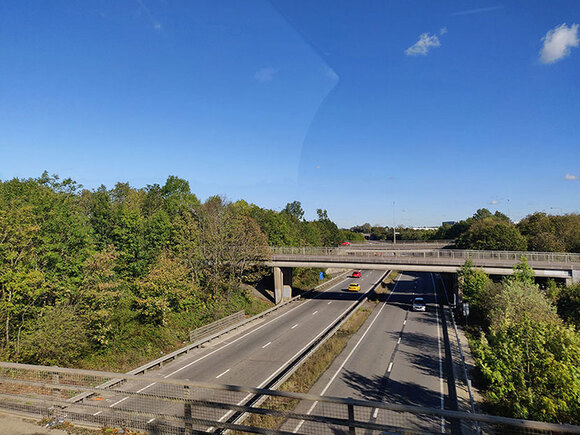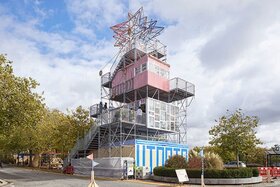On October 3th a symposium was organised in the British New Town Milton Keynes titled Utopian Radicalism, curated by INTI. The symposium was part of A Festival of Creative Urban Living which took place from October 26 to November 13. Examples of inspiring and experimental projects organised or initiated by residents or cooperatives were brought together. These projects serve as an alternative to the traditional top-down planning that was used in the past for the design of New Towns. Although this top-down planning is still the most dominant way of designing today, there has been a growing demand for a more active role, more freedom and more responsibility for residents. These exciting projects can serve as a source of inspiration for many New Towns, including Milton Keynes. Her ambition to expand requires experimental models that have never before been applied in Britain. The symposium may provide these models.
A Festival of Creative Urban Living
The theme of the festival was "The Built, the Unbuilt and the Unbuildable". raumlaborberlin, a creative and experimental architect collective based in Berlin, created the theme and the programme on behalf of Milton Keynes. They designed a festival campus on Midsummer Boulevard, the central boulevard that runs alongside the beloved, immense shopping mall, that served as the centre for design, architecture, and technology. Utopia Station was built on the central campus: a high tower made of scaffolding. This tower functioned as a creative machine where residents and interested participants could gather with architects and experts to brainstorm about creative solutions and ideas for the future of Milton Keynes.
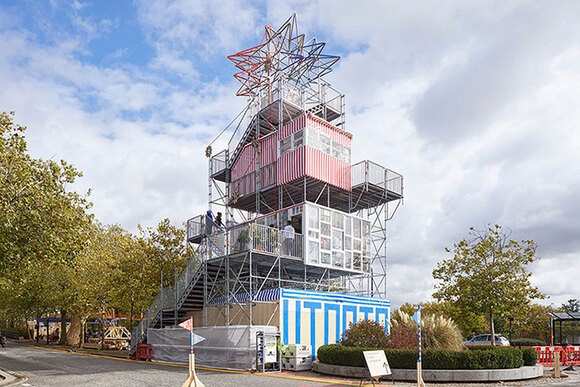
According to raumlabor, the involvement of residents in urban development is a requirement for a good process. The collective often focuses on residents and likes to delve into difficult urban environments. raumlabor argues that places that are in transition, abandoned or submerged by redundancy are places that lend themselves to experiments. If these places are activated in the right way, hidden potential often appears. The projects that were discussed during the symposium open up new perspectives that can break through traditional methods by looking for this potential in an alternative way.
Milton Keynes, the most successful New Town in Great Britain
Milton Keynes is a prominent example of the New Towns Movement of the 1960s. Besides being the largest British New Town in Britain, it also claims to be the most successful. The city was built according to the ideals of the Garden City movement. It features wide boulevards, a grid system, modern architecture and lots of greenery. The central position between London, Oxford, Cambridge, and Birmingham makes Milton Keynes an attractive place for international companies. The city also has a segregated traffic system, whereby the routes of the car and those of the pedestrian and cyclist do not have to cross each other.
Although these principles sound very idyllic, Milton Keynes also faces some major challenges. The city is one of the fastest-growing cities in Great Britain. The population is expected to exceed over 300,000 inhabitants in 2027. Therefore, Milton Keynes is looking for alternative plans that can contribute to a pleasant living environment for all these newcomers. This resulted in The Festival of Creative Urban Living, where these ideas could be formed and collected. The festival offered a free programme of exhibitions and lectures that searched for an answer to the question: How can we pleasantly live in the city - and how can we continue to do so in the future? From this broad discussion, the debate is opened for the revision of Milton Keynes’s urban planning ideals.
Spijkenisse, Rotterdam, and Almere
Jan Knikker (partner in the Rotterdam architectural firm MVRDV) opened the symposium with a lecture on several projects from MVRDV. He created a bridge between Milton Keynes and MVRDV’s projects by introducing another New Town: Spijkenisse (municipality of Nissewaard). Just like Milton Keynes and London are connected, Spijkenisse was designed to accommodate the great housing pressure of Rotterdam. However, a common problem of New Towns rapidly appeared: how do you create identity and quality in a city if its main purpose is solving the housing crisis? MVRDV was invited in this context to design an iconic library. Not only would this library tackle the great illiteracy of the inhabitants of Spijkenisse (that lies between 274 and 278, while the Dutch average is 284), the city would also get another icon that could promote a positive identity of the city. MVRDV came up with De Boekenberg: a pyramid-shaped glass building in which shops, meeting rooms, meeting places and a library come together.
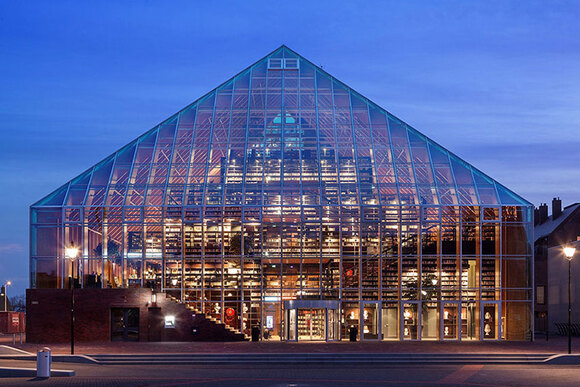
MVRDV has used this method of designing iconic architecture before in Spijkenisses’ mother city: Rotterdam. Just as the Guggenheim is the crowd puller for Bilbao, the Markthal served to attract tourists to Rotterdam. Inviting a large internationally renowned architectural firm to a city appears to be an effective way to promote a city. Not only does De Boekenberg fight the illiteracy, but it also serves as an icon for the city. The opening of the Markthal also led to considerable growth in tourism. Perhaps an idea for Milton Keynes?
In addition to designing iconic architecture in New Towns, Knikker talks about a completely new form of urban design. He introduced the Oosterwold area in the Dutch New Town Almere. Just like Milton Keynes, Almere expects a so-called scale jump. The city aspires to be the fifth largest in the Netherlands and decided to do this in a unique way. MVRDV was invited to design a plan for the 43,000-hectare land of Oosterwold. It’s not the municipality, but the residents who are the developers; not only of the houses but also of streets, public spaces, pipes, and greenery. In return, the residents can buy land for a relatively cheap price. They can build freely on their land if they abide by a few ground rules: 59% of the land has to be spent on food production, 2% on water, 13% on green public space, 8% on roads and 18% on building construction. They can work together, set up collectives and create public space together. According to Almere and MVRDV, this freedom results in greater involvement and a greater sense of responsibility towards their living environment. This makes Oosterwold a unique project that could perhaps serve as an example for other New Towns.
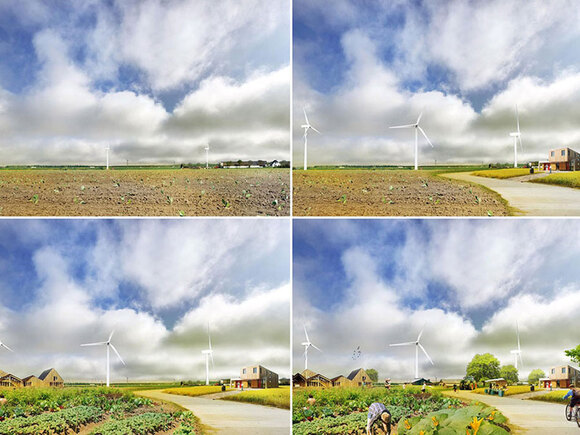
We’ll build it ourselves!
The first part of the symposium was entirely devoted to the motto: “We’ll build it ourselves!”. During this part, three speakers presented a unique project in which traditional ways of urban development were disregarded and residents took matters into their own hands.
Piet Vollaard, architect, architecture critic and former director of ArchiNed, has been part of City in the Making since 2014. The organisation, which fights for the reactivation of vacant buildings in Rotterdam, originated during the time of the economic crisis in the Netherlands. Their alternative method of urban development contributes to an affordable and sustainable way of living in the city. They obtained their first property through the Havensteder housing association because the building, that was bought during the crisis, would otherwise remain vacant for years. City in the Making offered to maintain the building in exchange for its temporary use to which Havensteder agreed. The building was transformed into a home and the ground floor became a place for various social activities. Vollaard shows that communities can be established through this hands-on approach. However, although the buildings created a sense of community and contributed to society, they ended up back in the hands of the housing associations after a few years. Temporality is City in the Making’s biggest weakness and therefore, they aim to expand the initiative with properties that are purchased and withdrawn from the market for good. A good example and a great source of inspiration is the German organisation Mietshäuser Syndikat. This organisation brings together around 120 different autonomous living groups throughout Germany. Their buildings are collectively maintained by the residents who pay rent to their cooperative as well as a small amount to the umbrella organisation. The latter has a share in all individual projects, advises on funding and has a decisive share in every residential group that prevents the sale of the houses. The rent that goes to the houses that have been paid off is used to finance the start-up of new projects.
Initiatives like Mietshäuser Syndikat can be established in Germany because of the trust of German banks. Although the payment behaviour of these cooperatives is often more stable than that of private individuals, Dutch banks lack this trust. However, enthusiasm is increasing: a good example is the first independent housing cooperative in the Netherlands: The Warren. Jovanka Stoimenovski talks about the building complex that will emerge on IJburg, a part of the artificially constructed Centre Island in Amsterdam. The Warren is a combination of social rent, sustainable self-construction, and communal living and will consist of 36 social and middle rental homes which will be realised sustainably and socially. A group of 50 active members is fighting for an affordable future that provides care for each other, for the environment and for the city. In exchange for cheap land, the cooperative guaranteed the municipality that the homes will remain available for low and middle incomes. The design of the project is based on the concept of a circular economy: energy will be supplied sustainably, sustainable materials will be used and there will be no gas facilities. The organisation hopes to inspire other people and to create a revolution on the Amsterdam housing market. They distinguish themselves in terms of design and joint decision-making because residents are also co-owners of the cooperative. This has never happened before in the Netherlands and, therefore, causes some difficulties. Just like City in the Making, the organisation is struggling with finances because Dutch banks are reluctant. Hopefully, organisations like City in the Making and the Warren will lead the way for other, similar initiatives.
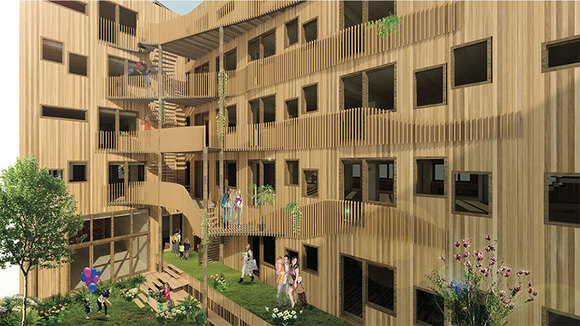
Another project where initiators have taken matters into their own hands is Welcome into my Backyard (WiMBY!), that started 20 years ago in the Dutch New Town Hoogvliet. Michelle Provoost was one of the developers and talks about two co-housing projects realised together with residents and how they have developed since construction. Just like Milton Keynes, Hoogvliet has often been negatively exposed. The city was declared a failure and had to be reinvented, according to the former city council. An ambitious plan was set up to renew the existing residential areas. Hoogvliet would be transformed from a sleeping city into an attractive, cultural and diverse city. What distinguishes this project from the other two projects is the collaboration with housing corporation Vestia that testifies of the enthusiasm from top-down parties. Also, the projects were completed in 2005, which gives the unique opportunity to learn from the successes and the mistakes years after construction. The two co-housing projects consisted of 40 homes for musicians, and 60 homes for an eco-group. By offering homes that cannot be found elsewhere, the New Town was able to attract a diverse audience. The musician-houses were provided with an isolated and large underground space in which music could be made undisturbedly and the eco-houses were provided with a communal collective garden.
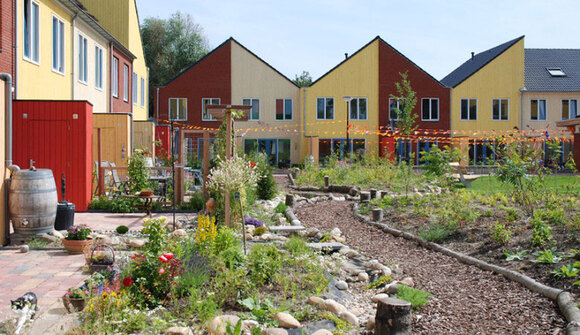
The project shows that a collaboration with a housing association can also lead to an experimental and original way of housing that can contribute to improving the image of a city. Now that the neighbourhoods have been in use for ten years, it has become clear that the management and the allocation of housing to residents demands extra attention of the housing association, who do not always have the time and resources to meet these requirements.
Using Modernist Legacy in a Radically Different Way
Many New Towns are built according to modernist principles, with functional public space and industrial housing and offices. But also, according to the ideals of the post-war era, with an emphasis on the open society, emancipation and freedom. Some of the physical elements of the New Towns are outdated, while others may regain their value after an update. In the second part of the symposium, examples are introduced that use traditional blueprint-urbanism and the modernist architectural legacy as a starting point and then use them in a radically different way.
The previously introduced Berlin-based architect collective raumlabor presents one of these innovative projects. Lukas Hamilcaro, project manager of the festival, talks about the Haus der Statistik, a former GDR building in Berlin. Just as in many other large cities, Berlin faces a large housing shortage. The Haus der Statistik has been vacant for ten years which resulted in great dissatisfaction among activists. This resulted in the foundation The Haus der Statistik which has succeeded in preventing the sale and demolition of the building. Since then, various groups and parties have been working together to transform the building into an inclusive place for artists, refugees and other residents. By using the modernist legacy, the building is used in a radically different way. Under the slogan ‘a protected space for the temporary’, raumlabor participates in the renovation of the building to transform it into a place for co-housing, co-working and co-living; a place for education and a home for refugees.
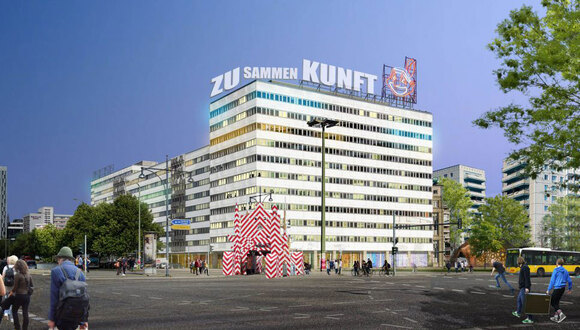
Another project that comments on the functional nature of public spaces in New Towns and offers a radical alternative is Amsterdam Allegories, a design by Alessandra Covini (Studio Ossidiana). According to Covini, public space must be an inclusive and non-artificial space that promotes interaction between humans, animals and plants that results in a new concept of identity. With her fictional design for Amsterdam Noord, she won the Prix de Rome. The north of Amsterdam will become a new centre in the city due to the expansions on the north bank. An island will be realised on the IJ and Studio Ossidiana transformed a part of this into a large public space. This dream-like space can only be reached by boat and consists of various worlds that you can interpret to your own taste. On the island, action is central rather than production and the spectator transforms into the user. The project is a search for a new form of public space. Old, modernist traditions are used as a starting point but are radically transformed. The traditional premise of public space as a place for relaxation is transformed into a place of action, surreality and discovery in Covini’s design.
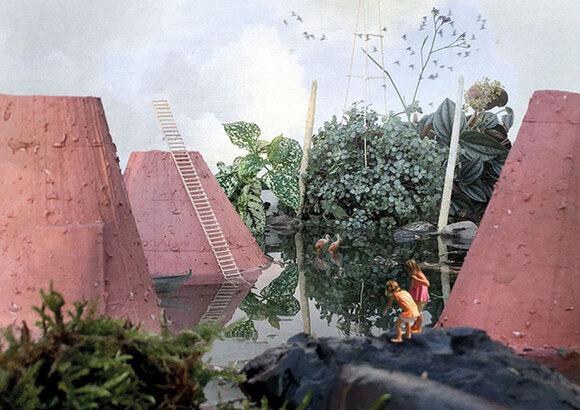
Verena and Christoph Mörkl, working at the Viennese architectural firm SUPERBLOCK, present the Wohnen mit Scharf! housing block. Unlike many other large cities, Vienna offers many affordable rental properties. 70% of the homes are rented and are owned by the city or managed by non-profit organisations. The latter have to consider the community’s needs and have to invest their profit in new social housing projects. Their projects are often developed by architects through competitions. A jury judges the submitted projects on their social sustainability, rental prices, ecology and architecture. The project Wohnen mit Scharf!, designed by SUPERBLOCK, won one of these competitions. The idea of their design was inspired by the magazine Biber mit Scharf, which particularly appeals to young people with a migration background. Wohnen Mit Scharf! is a residential complex that consists of 51 apartments spread over eight floors. The ground floor has a public area of 200 m2. The colour pink is used in collective areas to generate recognition and togetherness. The block includes a wide variety of apartments, each of which is designed according to different needs. First and second-generation immigrants and Neo-Austrians, in particular, constitute a significant part of the population of Vienna and are an important factor in the construction of subsidised housing such as this. With the mix of residents in the block, the modernist concept of "community" takes on a new shape. In addition, it is eligible for "super grants" from the city of Vienna making it easy for tenants to participate in the project, mainly tenants with an immigrant background. This achievement of generating diversity is an inspiration to many New Towns.
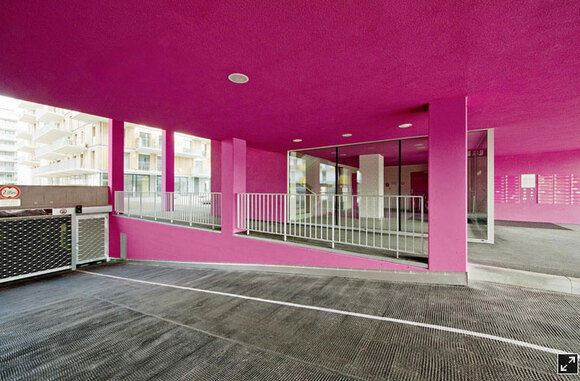
In the projects presented during the symposium, the few themes repeatedly appeared: the creation of identity, the need for more freedom for residents, the need for cheap real estate and the emergence of new actors in urban development. The first part of the symposium focused on "We’ll build it ourselves!". Traditional top-down planning has been replaced with more freedom and responsibility for residents. City in the Making reactivates vacant houses and thereby contributes to the neighbourhood on their own initiative. A project like the Warren has never before occurred in the Netherlands and their initiative and effort is leading the way for more self-building cooperatives in the Netherlands in the future. And in Hoogvliet, WiMBY! attracted a diverse group of people by collaborating with a large housing corporation because they offered more freedom and a unique way of living. All projects share the concept of freedom and experiment. In the future, more space needs to be created for such projects and more confidence should be generated among project developers, housing associations and banks. Corporations do not yet dare to put their trust in these initiatives and most people are not yet used to this much responsibility. That is why these experimental projects are crucial for the future. The second part of the symposium focused on "Using Modernist Legacy in a Radically Different Way". raumlabor breaks with the former DDR identity and creates an inclusive place for various groups, Alessandra Covini experimentally creates a concept of identity with her public space design and the Viennese architectural firm SUPERBLOCK creates a housing block for a diverse community. These projects all contribute to a change in the way we design cities, especially New Towns. There is a growing need for alternative development concepts and methods in which the resident has a more central position. Besides, ways must be found to deal with growing polarisation within cities and to create more inclusive neighbourhoods. raumlabor and SUPERBLOCK, among others, design their projects for people that would normally be left out. City in the Making shows that old property can be perfectly suitable for starters, creatives and newcomers. Therefore, the symposium advises Milton Keynes not to immediately demolish old buildings to transform them into hotels, parking facilities or offices, but to give them to other less commercial groups that can contribute to the diversity and the liveliness of the city.



